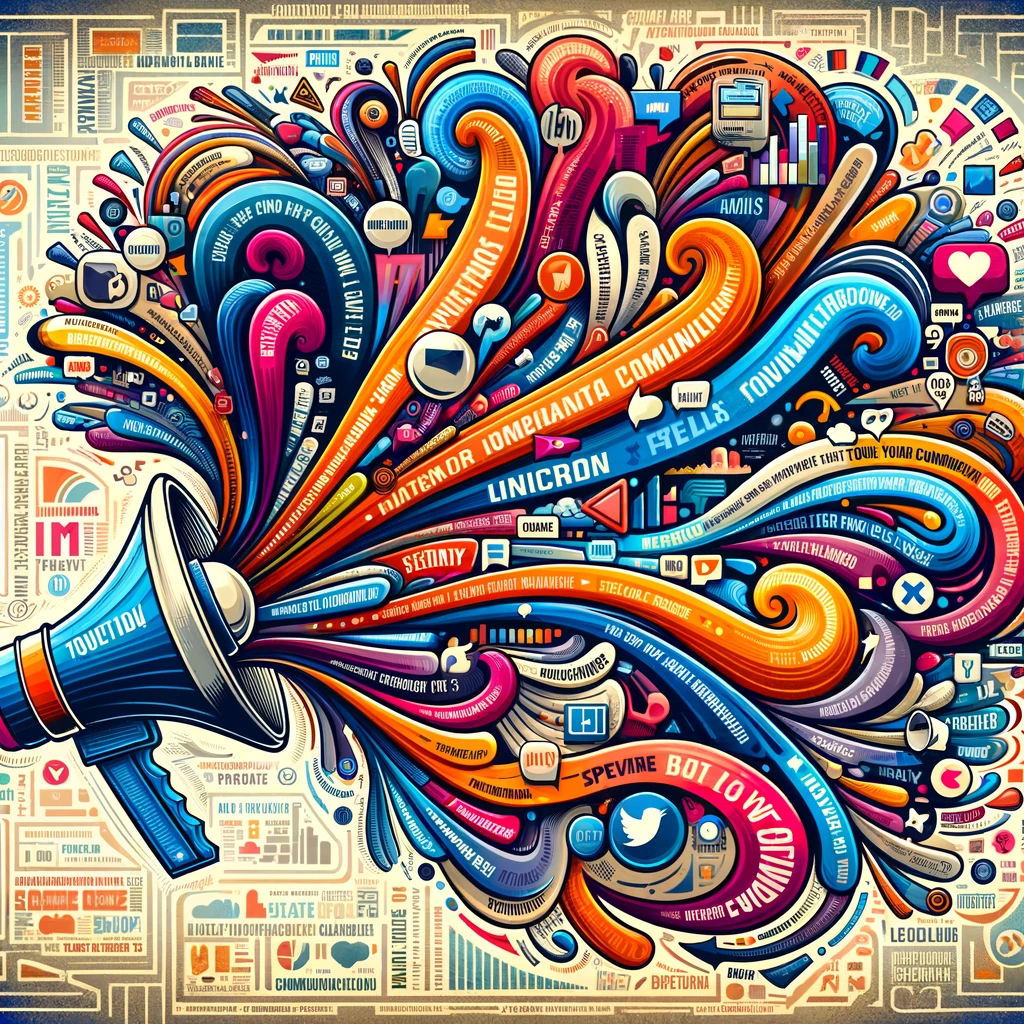Your brand’s identity is shaped by unique characteristics, ranging from names and logos to color palettes. This includes maintaining a consistent and recognizable tone of voice. The International Standards Organization highlights the importance of branding in forming distinct images and associations in stakeholders’ minds. Your brand’s tone of voice significantly contributes to building these perceptions.
Therefore, it’s crucial to understand the role of tone of voice in corporate branding: its definition, importance, and interplay with distinct speaking styles. The significance of a firm tone of voice is increasing as digital communication channels foster more interactions between brands and consumers. Additionally, the advent of voice bots, smart speaker apps, virtual assistants, and other conversational AI platforms alters consumer engagement with companies. This evolution requires distinguishing between two closely linked brand elements: tone of voice and speaking style.
To effectively enhance your brand, it’s essential to master both tones of voice and speaking style in written communications and through the emerging ‘Internet of Voice.’
What Is The Tone Of Voice In Communication For Brands?

The basic understanding is straightforward: Tone of voice is a uniform communication style. However, to maximize its effectiveness, it’s essential to meticulously manage the nuances of tone, ensuring nothing is left to chance.
Here’s a more analytical explanation of tone of voice:
- The tone of voice encompasses the aspects of language that convey identity, emotion, and character. It’s not about the specific words used but how they are presented.
- The tone of voice determines how an idea is conveyed rather than the idea itself. Creating a unique tone of voice involves carefully selecting words, sentence formation, perspective, and even punctuation, all aligned with your brand’s values. For example, an energy drink brand might adopt a straightforward, casual, second-person tone like, “You gotta try this stuff!” In contrast, a business insurance company might prefer a formal, technical tone: “In today’s uncertain economic environment, every business owner needs protection from liability.
Developing a tone guide for communication staff is crucial for designing your brand’s tone of voice. Your brand’s tone of voice is obvious too when you talk to your customers through your cloud contact center. A comprehensive guide is something all of your teams can make use of. The critical factor here is consistency. The tone must be uniform across all platforms to forge a strong brand identity. If humor is a part of your social media strategy, maintain a similar tone on your website. Similarly, if your brand embodies authority and seriousness, ensure the language remains formal across various mediums like blogs and newsletters.
Language manifests in two forms: spoken and written. Branding’s tone of voice applies to both. Most branded speech originates in written form, but there’s a distinction between tone of voice – encompassing word choice, sentence structure, and formality level, observable in scripts or print ads – and distinct speaking styles, which is the application of tone in spoken communication. This can be referred to as the ‘tone of speech.’
What Is The Tone Of Speech In Brand Communications?

While the tone of voice determines the choice of words, the tone of speech concerns how those words are expressed. The former shapes scriptwriting, while the latter defines the delivery of the script. Essentially, tone of speech in speaking is analogous to tone of voice in writing, although they often intersect as written texts are frequently spoken.
To elaborate, speech scientists refer to the words in speech as “linguistic information,” which is the core content of the message. The tone of speech, on the other hand, encompasses all aspects beyond this linguistic content. This includes factors like emphasis, emotion, inflection, intonation, pauses, filler words like “um” and “like,” and the distinct sound of a person’s voice. Collectively, these elements constitute a speaking style. For brands, this style plays a crucial role in shaping their relationship with customers.
Speaking Style, Emotion, and Brand Personality

Speaking style, emotion, and personality are intrinsically linked. Describing a speech style involves conveying emotions like happiness, sadness, or anger. This is crucial for companies creating synthetic voices, as they aim to emulate a genuine human connection between their brand identity and consumers. Emotion serves as the essential link in this interaction. To understand the impact of speaking styles on emotional connections with brands and overall consumer experiences, consider this example:
Imagine you are calling your bank to finalize the payment of a long-standing credit card debt. The response you receive could be one of two:
1. An enthusiastic congratulations with a $10 client gift card reward and an offer to discuss a higher credit limit.
2. A simple acknowledgment of the payment with no further engagement.
The choice of response can significantly influence customer loyalty or lead to loss of business, highlighting a direct link between tone of voice, speech content, and brand reputation. When it comes to reputation management even the smallest details can prove to be crucial. It also applies to casual interactions through voice bots or voice ads on streaming services.
Jennifer Aaker, a marketing theorist, contributes to this understanding with her theory of brand personality, which she defines as “a set of human characteristics associated with a brand.” Her research categorizes brand personalities into sincerity, ruggedness, excitement, competence, and sophistication, each with corresponding traits.
These traits are reflected in voice characteristics. For example, a rugged voice might sound low and rough, while a sincere voice appears honest and cheerful. The tone of voice offers insights into the speaker’s identity.
A unique voice with a suitable speaking style is essential in expressing this identity. When training customer service agents or developing a Text To Speech (TTS), voice aligning the speaking tone with the brand’s persona is critical. This is especially vital when expanding the brand’s voice across audio channels like in-store announcements, smart speaker apps, and automated phone systems. A distinct TTS voice that accurately represents a brand is critical, and tone of speech plays a significant role in this endeavor.
Controlling Speaking Styles with AI-powered Text To Speech

Wavel AI, though not a branding agency, collaborates closely with such firms and stands as a leader in custom digital voice design with a robust research division constantly advancing the science of Text To Speech (TTS) technology. This positions Wavel AI as an ideal partner for bringing a unique voice that mirrors your brand identity to life.
Wavel AI creates bespoke TTS voices, which is essential for any company engaging with consumers through voice computing. While the alternative might be to use a generic or default TTS voice from major tech companies like Amazon or Google, there are risks associated with this approach:
– Lack of brand equity ownership. Using a standard voice, like Alexa’s, for your branded skill means consumers associate their experience with Amazon rather than your brand.
– The danger of sharing a voice with a direct competitor, which detracts from establishing a distinctive brand presence. An independent digital voice partner like Wavel AI ensures your brand’s uniqueness with a voice that resonates as distinctly as your logo.
Speaking styles in TTS play a vital role in a brand’s synthetic voice. Wavel AI offers several ways to tailor style while designing your TTS voice, including:
– Emotionally expressive TTS. Similar to interpersonal communication, the emotional tone in TTS should align with the context. Wavel AI’s neural TTS voices can express emotions like sympathy, excitement, or anger. Additionally, these conversational platforms can dynamically adjust emotions by integrating emotion recognition tools through partnerships to match user moods.
– Customized emphasis. Different emphases can subtly alter meaning, as in “GET on that bus” versus “Get on THAT bus.” Wavel AI can integrate specific emphasis patterns into your TTS voice to support desired moods or personalities.
– Tailored speaking speed and rhythm. For instance, an energy drink brand might opt for a faster-speaking TTS voice to convey excitement, unlike a bank’s. Pausing patterns also shape identity, as in the difference between “I…think so” and “I think so!” Wavel AI’s TTS technology can utilize these elements to communicate your brand’s unique character effectively.
When exploring the capabilities of Wavel AI’s Text To Speech (TTS) technology, one standout feature is its cross-lingual TTS capabilities. This allows your brand to maintain its unique character to communicate in multiple languages, broadening your brand’s reach and appeal globally. To truly appreciate how control over the tone of voice in TTS can enhance customer connections, it’s insightful to look at real-world examples. Here are a few use cases that demonstrate the significance of tone of voice in TTS-driven brand interactions:
1. Customer Service Chatbots: A company using TTS for its customer service chatbots can tailor the tone to be more empathetic, friendly, or professional, depending on the interaction context. For instance, a Whatsapp chatbot handling customer complaints might use a more sympathetic and understanding tone to diffuse customer frustrations and improve the overall experience.
2.Multilingual Marketing Campaigns: Brands operating internationally can leverage cross-lingual TTS to ensure their marketing messages resonate culturally and emotionally with diverse audiences. By adjusting the tone to suit different languages and cultural norms, The Poster Maker adds a layer of personalization and engaging experience for each target market.
3. E-learning Platforms: Educational content delivered via TTS benefits significantly from an engaging and easy-to-follow tone. A lively and energetic tone can be employed for subjects requiring enthusiasm to maintain student interest. Conversely, a clear and steady tone can enhance comprehension of complex topics that demand concentration.
4. Healthcare Reminders and Information: TTS is used for patient reminders or informational content in healthcare. A calm, reassuring tone in multiple languages can make healthcare information more accessible and less intimidating, especially for critical health messages, peptide therapy messages or medication reminders.
5. Voice Assisted Devices in Retail: TTS can be used for announcements or assistance in retail environments. The tone can vary from promotional and enthusiastic when announcing a sale to clear and informative for in-store navigation or product information.
Conclusion
The tone of voice and speaking style are vital components of a brand’s identity, significantly influencing how it communicates and connects with its audience. Wavel AI’s advanced Text To Speech (TTS) technology offers an array of possibilities for brands to establish a unique and engaging voice presence, enabling a deeper and more personalized interaction with consumers.
Whether through customer service chatbots, multilingual marketing campaigns, e-learning platforms, healthcare communications, or retail voice-assisted devices, the ability to tailor the tone of voice and speaking style to suit specific contexts and audiences is crucial. Wavel AI’s cross-lingual capabilities and customizable speaking styles ensure that a brand’s voice remains consistent, distinctive, and resonant across different languages and platforms.
By carefully crafting and controlling the tone of voice and speaking style, brands can enhance their identity, improve customer experiences, and foster stronger connections with their audience. Nowadays, you can even use an AI logo generator to come up with a logo and enhance your brand identity. In the evolving landscape of digital communication and conversational AI, the strategic use of TTS technology becomes an invaluable tool for brands looking to stand out and make a lasting impression.
Frequently Asked Questions
1. What is ‘Tone of Voice’ in Wavel AI’s Text To Speech Technology?
In Wavel AI’s Text To Speech (TTS) technology, ‘tone of voice’ refers to the distinct style and emotional expression infused into the synthetic voice. It encompasses pitch, tempo, and emotion, allowing the TTS voice to consistently convey a specific character or brand identity across different platforms and languages.
2. How Does Wavel AI Handle Different Speech Tones?
Wavel AI’s TTS technology is equipped to handle a variety of speech tones, from professional and formal to friendly and casual. This flexibility allows brands to customize the speech tone of their ai voice to align with the context of the communication, ensuring a more natural and engaging interaction with users.
3. Can You Explain What ‘Tone’ Means in the Context of Voice Communication?
Tone’ in voice communication refers to the quality, pitch, strength, and emotion conveyed through speech. It’s more than what is said but how it is said. Tone can convey various emotions and attitudes, making it a crucial element in effective communication, especially in TTS technology, which helps make the synthetic voice sound more human-like and relatable.
4. How Can Brands Benefit from Using Wavel AI’s TTS Technology?
Brands can leverage Wavel AI’s TTS technology to create unique and memorable voice experiences for their customers. By customizing the tone of voice and speech style, brands can strengthen their identity, enhance customer engagement, and provide more accessible and inclusive communication. Additionally, the cross-lingual capabilities of Wavel AI allow brands to interact with a diverse global audience effectively.

.webp)










